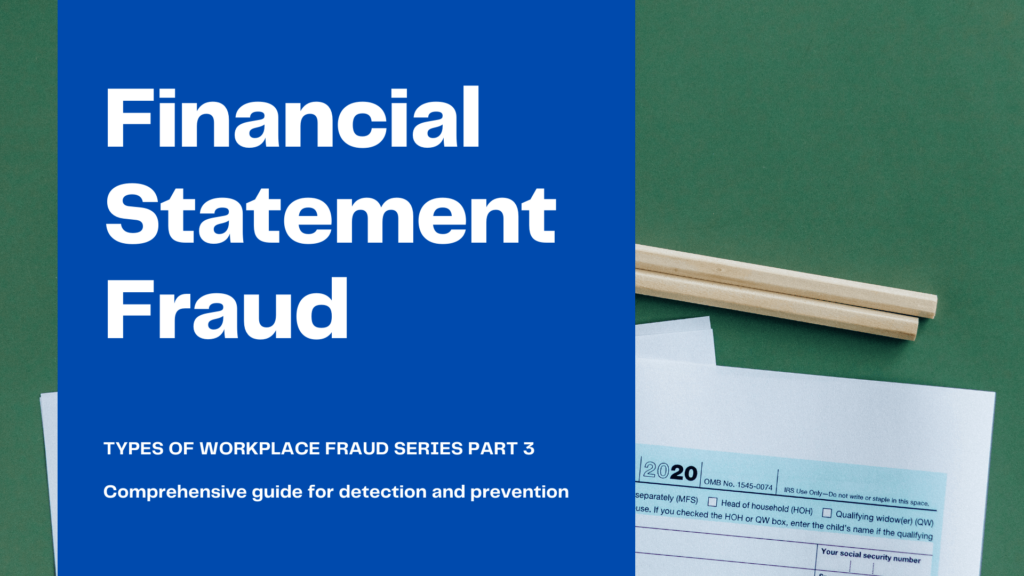Welcome back to part 3 of our 4-part series on types of Workplace Fraud.
In part 3 of our 4-part series on types of Workplace Fraud, we will cover:
- Asset Misappropriation
- Corruption
- Financial Statement Fraud
- Data, Intellectual Property and Identity Theft
Financial Statement Fraud remains a neglected and unmitigated risk for many organizations as it is one of the most costly types of frauds despite being the most common. It is important to identify areas of high risk, highlight the most likely schemes, and identify the red flags that warrant further investigation in order to protect yourself and your clients.

What is Financial Statement Fraud?
According to the University of California San Francisco, financial statement fraud is the deliberate over/under statement of financial statement balances in many cases to make a company appear to be in better financial condition than it really is to deceive a financial statement user.
Meanwhile, the Australian Securities & Investments Commission defines financial statement fraud as deliberately misleading or omitting amounts or disclosures in financial statements in an attempt to deceive financial statement users, particularly investors or creditors.
Misstatements in the financial statements can arise from either fraud or error. According to the International Auditing and Assurance Standards Board(IAASB), the distinguishing factor between fraud and error is whether the underlying action that results in the misstatement of the financial statements is intentional or unintentional. The International Standard on Auditing ISA 240 highlights the auditor’s responsibilities relating to fraud in an audit of financial statements.
Financial statement fraud takes the form of overstated assets or revenue or understated liabilities and expenses.
These schemes can be divided into two categories:
- Net Worth/Net Income Overstatements
- Net Worth/Net Income Understatements
Net Worth/Net Income Overstatements
Overstating assets and/or understating liabilities leads to increased net income on the income statement. This can be broken down into the following categories:
- Fictitious Revenues
- Manipulating Timing
- Concealed Liabilities and Expenses
- Improper Asset valuations
- Improper Disclosures
Fictitious Revenues
This occurs when an employee records phony revenues for goods or services that were never delivered. This can occur through:
- (a) inventing sales transactions; or
- (b) classifying other incomes or gains as sales.
One example is Commission Fraud:
This occurs when an employee inflates sales numbers to receive higher commissions, falsifies sales that did not occur or colludes with customers to record and collect commissions on falsified sales. Stock may be sent on consignment, but booked as a sale. Issuing fictitious invoices for sales that never happened can create recordable sales in the current period.
Potential red flags associated with fictitious revenues include:
- An unusual large amount of long overdue accounts receivable
- Outstanding accounts receivable from customers that are difficult or impossible to identify and correct.
- Significant volume of sales to entities whose substance and ownership is not known
- An unusual surge in sales by a minority of units within the company.
Manipulating Timing
This occurs when an employee deliberately records revenues or expenses in improper periods.
This may involve:
- Early revenue recognition
- Postponing expenses
Early Revenue Recognition
This involves bringing revenues from a later period into the current period, increasing revenues for the current period. By recording revenue early, a dishonest business seller or an employee under pressure to meet financial benchmarks can significantly distort profits.
Postponing expenses
This involves delaying booking expenses to the next period, decreasing the expenses and raising profits for the current period. The employee may only record expenses after the invoice arrives from the supplier. To postpone the expenses, the receipt of the invoice is not recognized and may be held in an Inbox until the start of the new period.
The most common liability that is underreported in an attempt to improve a company’s balance sheet is accounts payable. Techniques that may be utilized to omit accounts payable from the balance sheet include hiding invoices for goods and services received prior to year-end from the auditor and waiting until after the audit is completed.
The more common approaches to timing manipulation schemes are:
- recording a sale when there are still items or services to be provided;
- recording a sale before the sale contract has been finalized and before shipment to customers:
- recording a sale when items are sent on consignment, on approval, or with a right of return;
- recording a sale to associated parties; or
- recording a sale when an order is received
- issuing invoices for non-existent sales and recording the transaction.
In order to detect signs:
- Look for discrepancies between the quantity of goods shipped and quantity of goods billed
- Examine sales orders, shipping documents and sales invoices; compare prices on invoices with published prices; and note any extensions on sales invoices
- Compare the period’s shipping costs with those in earlier periods if you suspect merchandise was shipped prematurely; Significantly higher costs could indicate an early revenue recognition scheme.
- Sample sales invoices for the end of the period and the beginning of the next period to confirm the associated revenues are recorded in the proper period. If false sales are suspected, reversed sales in subsequent periods and increased costs for off-site storage may provide evidence of fraud.
Concealed Liabilities and Expenses
Concealed liabilities can include warranties attached to sales, underreported Incurred-but-not-Reported (IBNR) health benefits, or simple omission of liabilities. Examples include:
Expense Reimbursement Fraud
This occurs when an employee makes purchases on a personal card and submits an expense report, overstates expenses, purposefully submits duplicate reports, or creates fictitious expenses for items never purchased. While the amounts may be small to start, they can quickly add up over time if the fraud is not uncovered.
Workers’ Compensation Fraud
Most companies offer health insurance or workers’ compensation to their employees. Sadly, there are employees who try to profit off insurance by filing false claims or lying about injuries and illnesses, resulting in higher premiums and more out-of-pocket expenses for small business owners.
In this type of fraud, an employee exaggerates injuries or a disability, invents injuries that did not occur or attributes injuries that occurred outside of the work environment to work to receive compensation pay. Polonious is involved in a lot of these investigations on the insurance and investigation firm side, but it is important for the affected businesses to be aware of this type of fraud as well.
Procurement Fraud
This type of fraud includes schemes such as over-ordering products then returning some and pocketing the refund, purchase order fraud where the employee sets up a phantom vendor account into which are paid fraudulent invoices, or initiating the purchase of goods for personal use.
This may involve the following scenarios:
- Employee/Supplier Collision
- Conflicts of Interest
- Fake Companies
- Inflated Bills / Underdelivery
- False Statements in Obtaining Contracts
Employee/Supplier Collusion
This occurs when an employee arranges for a good or service with a vendor at either a higher cost than needed, or with a cheaper product. That vendor then “kicks back” money or gifts to the employee for the inflated deal terms.
Conflicts of Interest
This occurs when an employee responsible for vendor selection picks a company with some kind of relationship to them. Learn more about this scheme in part-2 of our 4-part series, Workplace Fraud: 7 Types of Corruption.
Fake Companies
If an employee creates a fake company and issues payments to it, those false costs build up. Oftentimes employees engaging in this fraud will make small payments so as not to raise alarms, and if a company doesn’t have a process to match invoices against purchase orders then it can be easy to commit.
Inflated Bills / Underdelivery
After the initial procurement phase, during the receipt of the contracted work, fraud can be committed either through the approval of inflated invoices or the acceptance of underdelivery. Underdelivery can be substandard work or failure to meet requirements. If an employee accepts subpar material, then that is a form of fraud — just as if they had approved of an inflated bill.
False Statements in Obtaining Contracts
This occurs when an employee makes or accepts false statements when obtaining contracts. Examples of this include misrepresenting a minority contractor or small business status, or a vendor making false statements of compliance.
Improper Asset Valuation
This scheme involves the improper valuation of inventory, accounts receivable, fixed assets, intangibles, or other assets.
Improper Disclosures
This involves the improper disclosure of material information, such as contingent liabilities, significant events, management fraud, related-party transactions, or accounting changes.

Net Worth/Net Income Understatements
Travel and expense budgets are a common target for financial statement fraud. This type of scheme is most commonly perpetrated by sales personnel who overstate or create fictitious expenses in areas such as client entertainment and business travel.
These schemes typically fall into the following categories:
- Manipulating Timing
- Understated Liabilities
- Improper Asset Valuations
- Improper Disclosures
- Expense Reimbursement Schemes
Manipulating Timing
This occurs when an employee minimizes current period earnings on the income statement by deflating revenue or by inflating current period expenses. An employee may do this for reasons such as:
- dissuade potential acquirers;
- getting all of the bad news “out of the way” so that the company will look stronger going forward;
- dumping the grim numbers into a period when the poor performance can be attributed to the current macroeconomic environment;
- To postpone good financial information to a future period when it is more likely to be recognized.
Understated Liabilities
An employee may downplay liabilities, as it represents a company’s financial obligations. For example, borrowers may forget to accrue liabilities for salary or vacation time. Some might underreport payables by holding checks for weeks (or months). This ploy preserves the checking account while giving lenders the impression that supplier invoices are being paid.
Improper Asset Valuation
Improper asset valuation schemes involve the improper valuation of inventory, accounts receivable, fixed assets, intangibles, or other assets.
Improper Disclosures
This involves the improper disclosure of material information, such as contingent liabilities, significant events, management fraud, related-party transactions, or accounting changes.
Expense Reimbursement Schemes
Expense Reimbursement Schemes fall into four general categories:
- Mischaracterized expenses
- Overstated Expenses
- Fictitious Expenses
- Multiple Reimbursements
Mischaracterised Expenses
This is one of the most common expense frauds which involves submitting a false claim to the employer. This typically involves submitting personal expenses as business-related expenses. They might, for example, charge your company for an expensive dinner with friends, claiming this as a “business dinner”, or expense hotel costs for a business trip they later turn into leisure.
Red flags for mischaracterized expenses include claims for:
- Items that don’t seem to have a business connection
- Meals and entertainment when employees aren’t working/travelling or on weekends or holidays
- Items or meals for children, or from
- Establishments in the employee’s neighborhood
Overstated Expenses
This type of scheme occurs when although the item incurred is a legitimate business expense, it is over-claimed by an employee. In this case, an employee may change the amount on a receipt, or “lose” a receipt and submit a claim for a higher amount than was spent.
For example, an employee may have stayed at a lower-price hotel or used lower-cost transportation and then created receipts showing higher-priced methods of transportation or accommodation.
Potential indicators of overstated expenses include:
- Incomplete or inadequate expense report
- Supporting documents such as receipts that are suspicious and/or show signs of fabrication (e.g. inconsistent font, color, visible correcting fluid/tape, pixelation, scratched out information)
Fictitious Expenses
This occurs when an employee creates a receipt for a product or service they didn’t receive and submit it for reimbursement. For instance, an employee may ask for a blank receipt and fill it in later. They may submit taxi, hotel, or other travel-related receipts despite not using them.
An employee may ask a taxi driver for a blank receipt and then fill in the information later. An employee might also create a fake receipt from scratch using an online template, or collude with a merchant to create a receipt for a non-existent purchase.
Here are a couple signs to look out for:
- Multiple expense reports submitted close together from the same company, from the same employee
- Taxi, hotel, flight, or other travel-related receipts for dates and times the employee was known to NOT be on company business
- Receipt amounts that are significantly higher than similar reports submitted by other employees
- Expenses that were not pre-approved
Multiple Reimbursements
This scheme involves an employee submitting the same expenses on multiple reports. For example, an employee can receive a reimbursement by submitting a receipt used for business travel. Later, the same employee can submit an email confirmation of reservation or credit card statement as a second proof of payment and get reimbursed twice.
In order to detect this type of fraud:
- Compare dates, amounts, and payees claimed on one report to those on other reports from the same employee.
- Look for evidence of the original version of a lost receipt connected to another expense report.
- Be careful not to accuse the employee before you are sure it was done on purpose, as this type of scheme could occur due to employee error.
Further signs which may indicate Financial Statement Fraud include anomalies in:
- Profitability
- Cash Flows
- Assets
- Liabilities
- Relations between financial statement items
Going Forward
Financial statement fraud can be an easy scheme to perpetuate, by simply doctoring a receipt or changing a date on an invoice. It can take some time for them to become apparent, at which point there can be significant issues. If you suspect there may be financial statement fraud schemes within your organization, you need to collate and compare all your statements to check for any anomalies, and particularly any patterns to these anomalies.
With such a large amount of evidence to go through, it is important to have a system to securely manage your evidence and ensure that your process is rigorous. Polonious’ case management system allows you to securely store documentary evidence including invoices, scanned or PDF receipts, and so on, and preview them within your browser, while our workflows ensure all fraud investigations follow a rigorous process.
Let's Get Started
Interested in learning more about how Polonious can help?
Get a free consultation or demo with one of our experts




